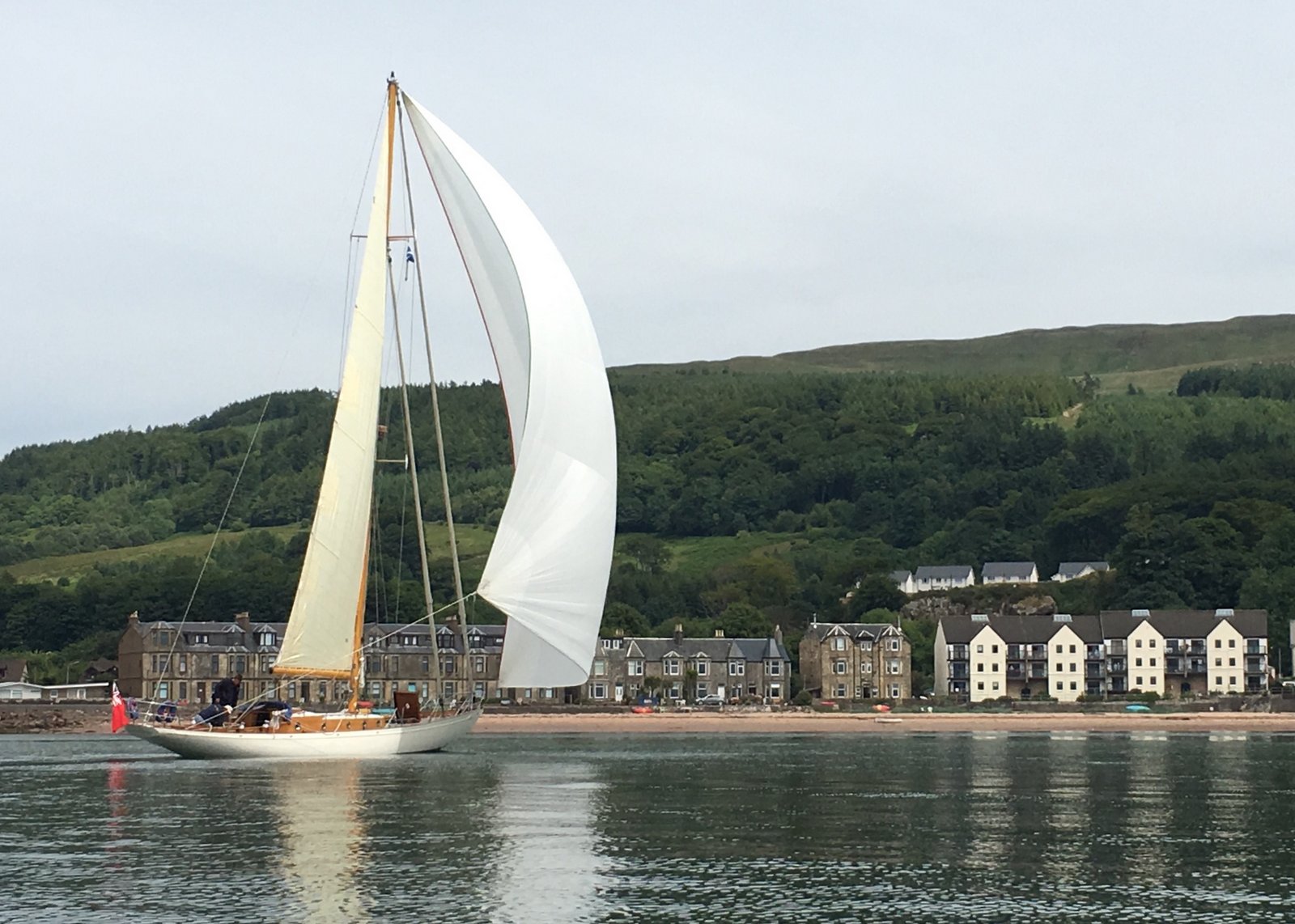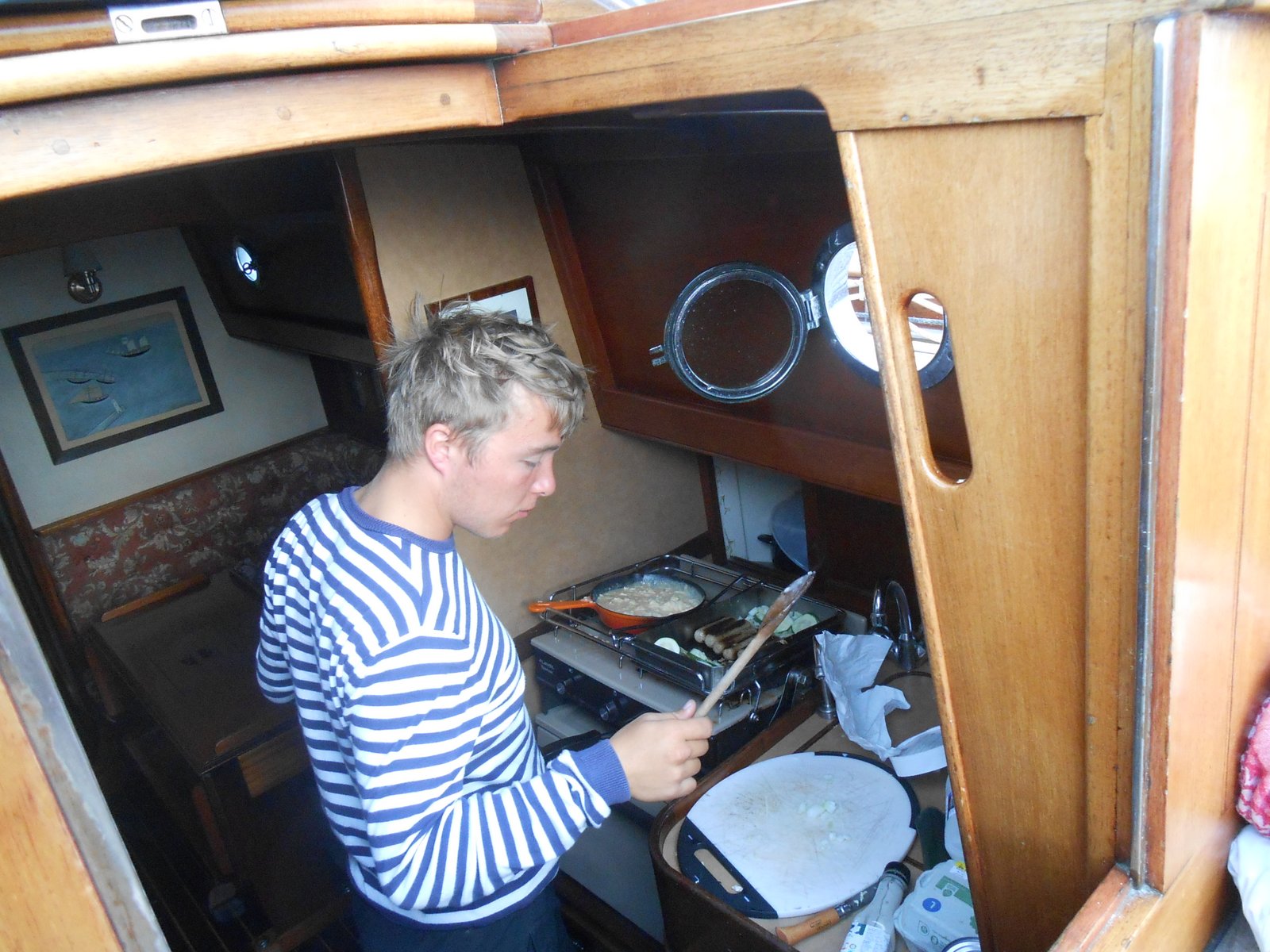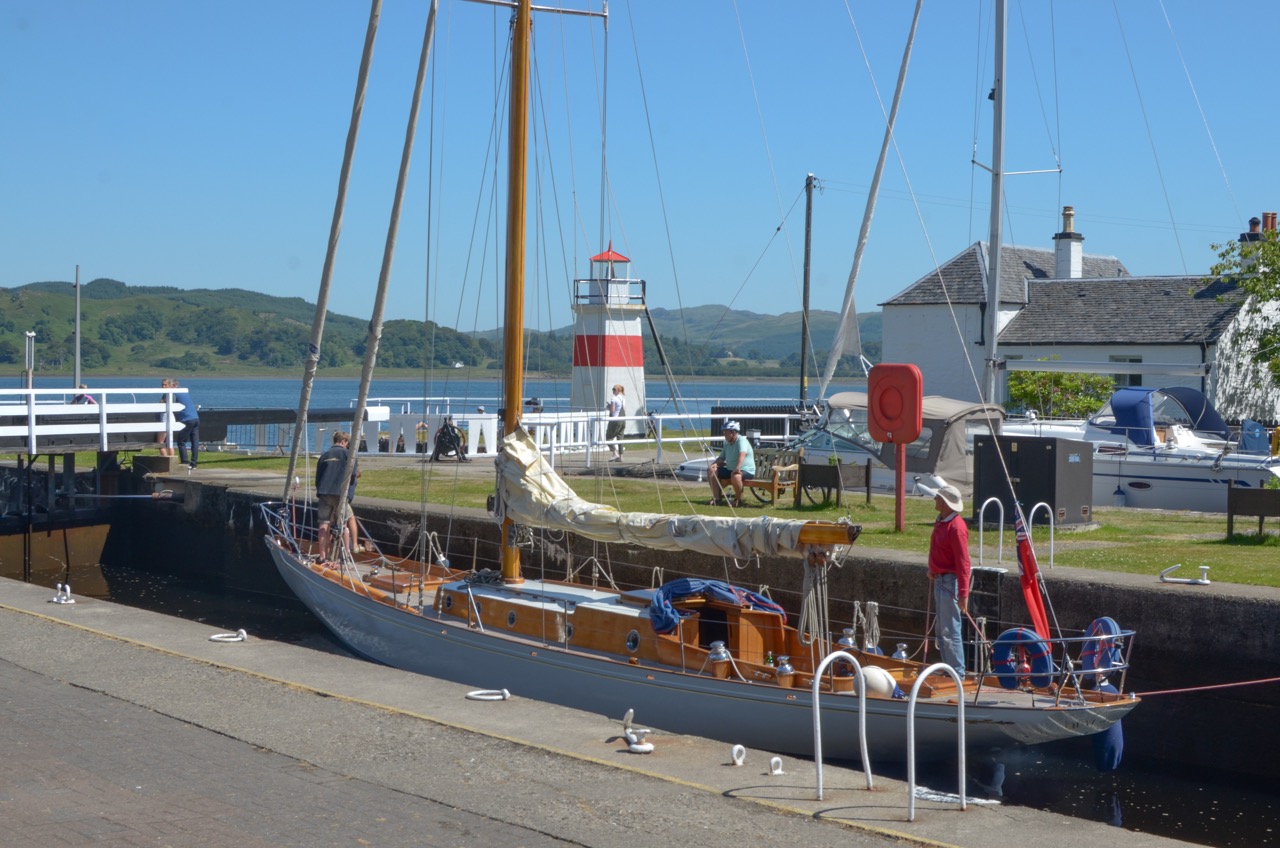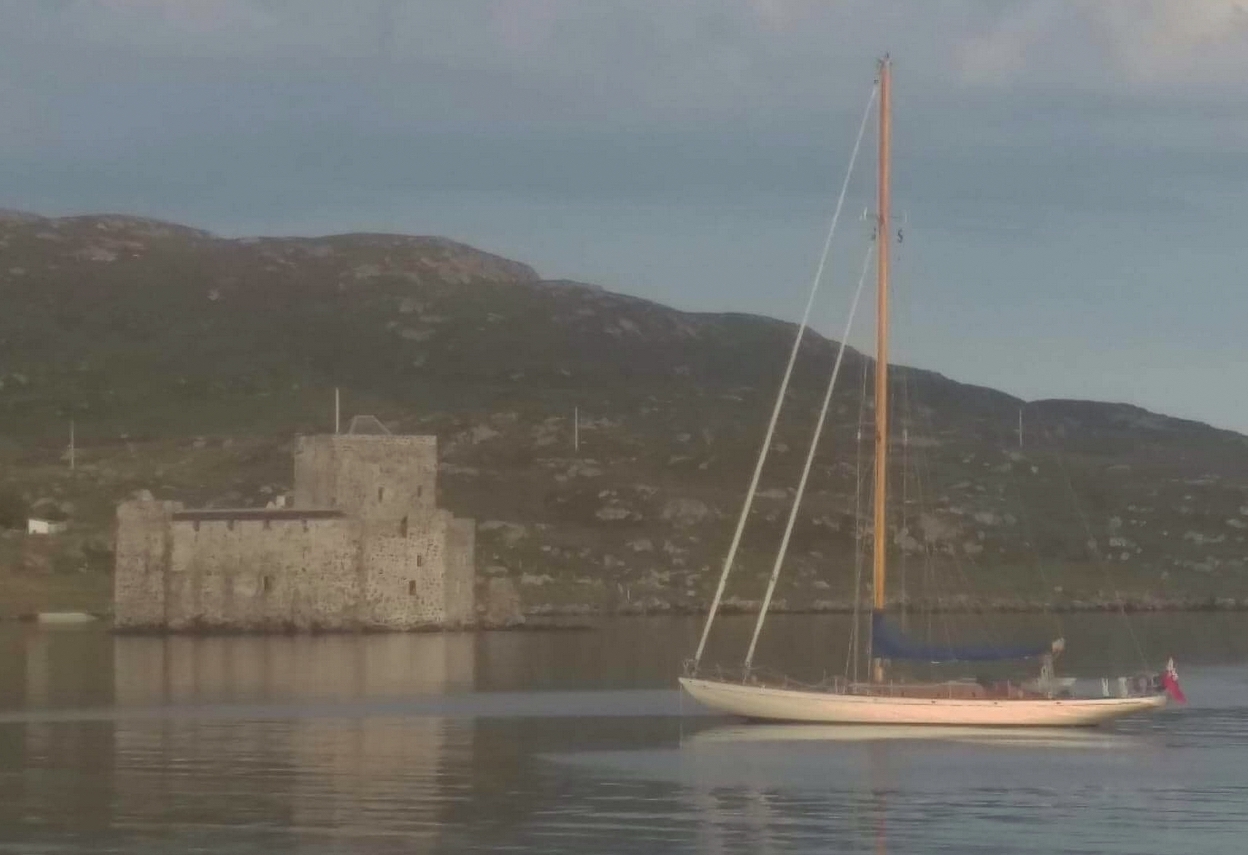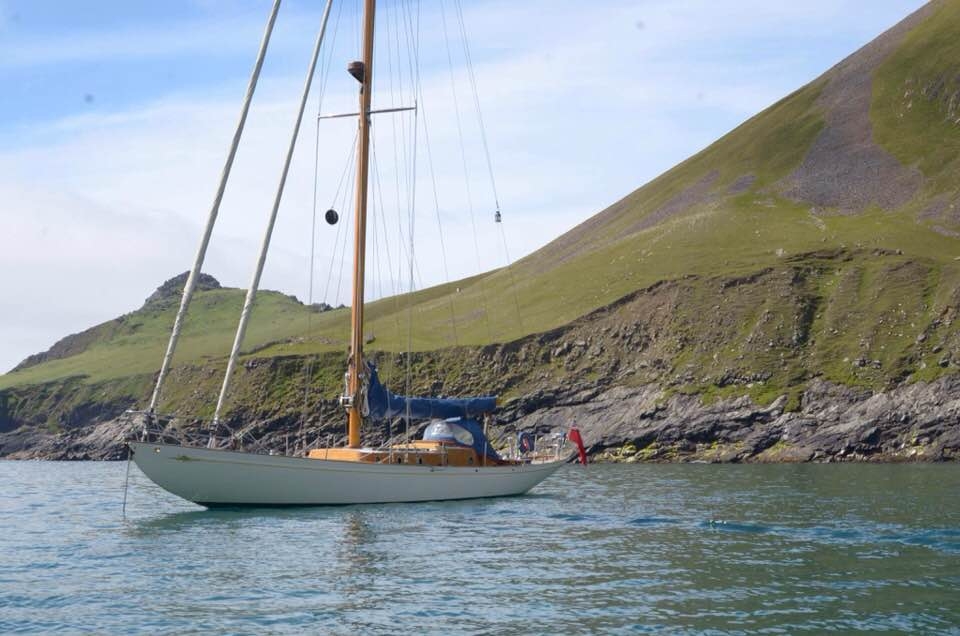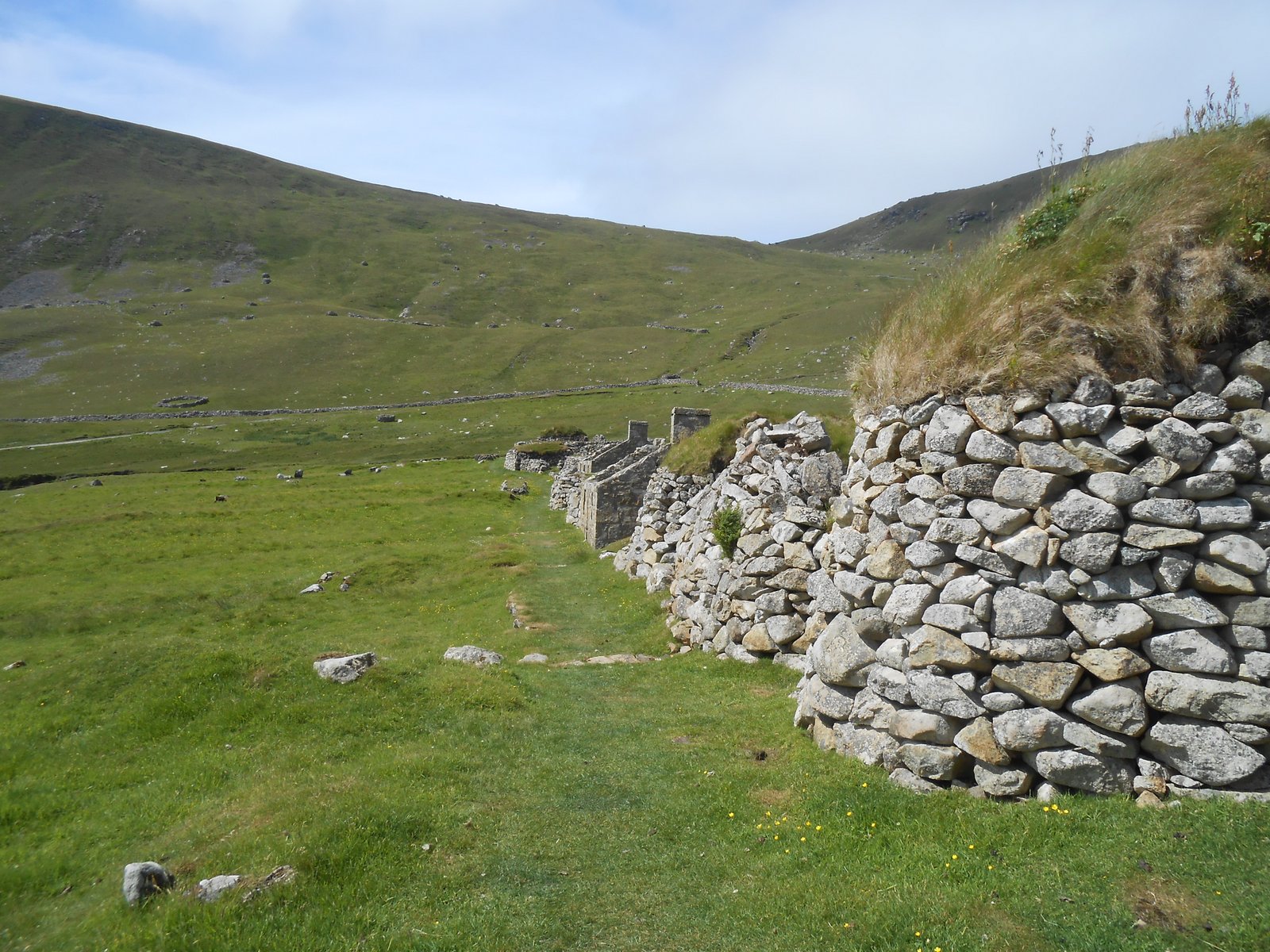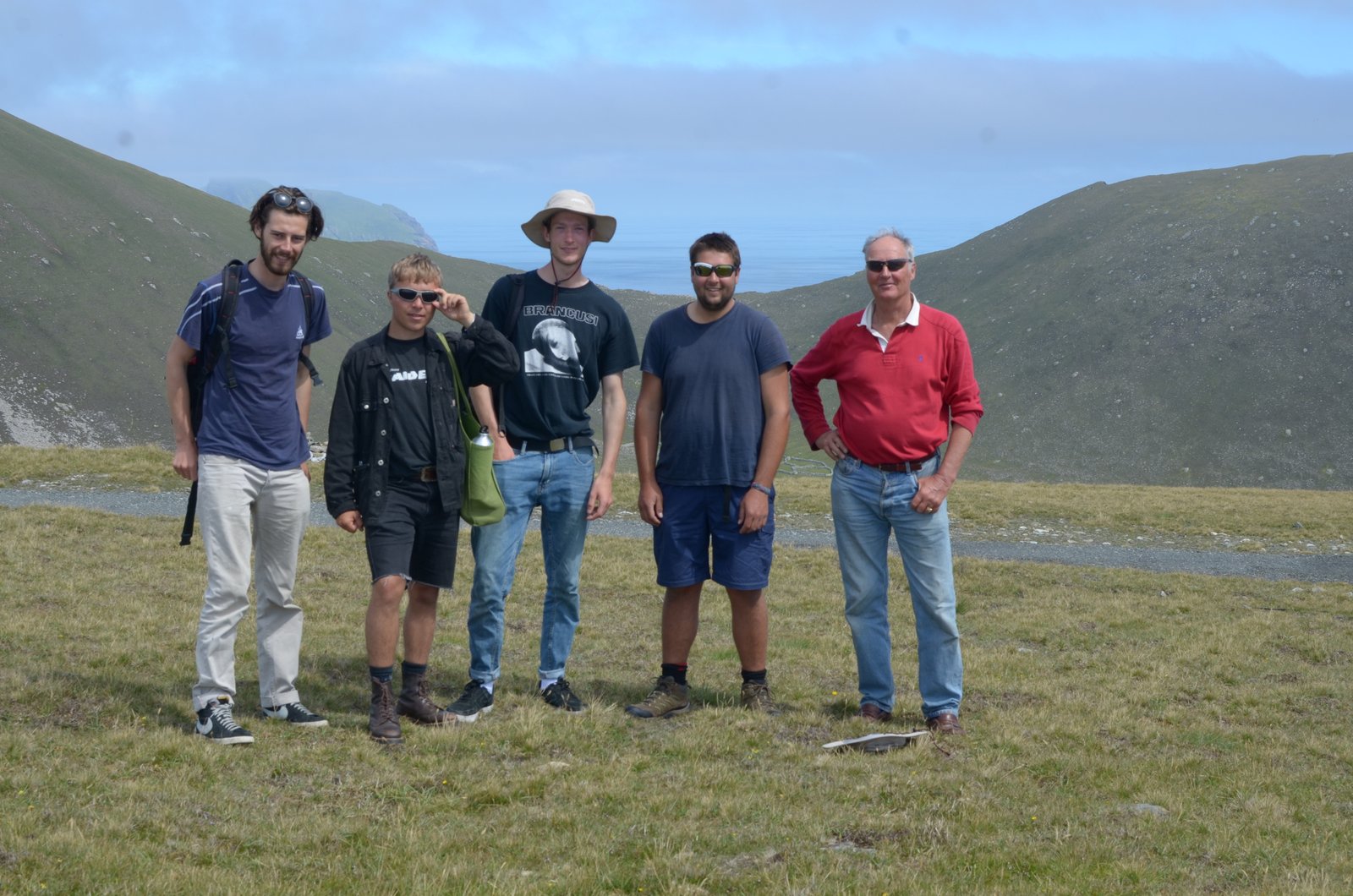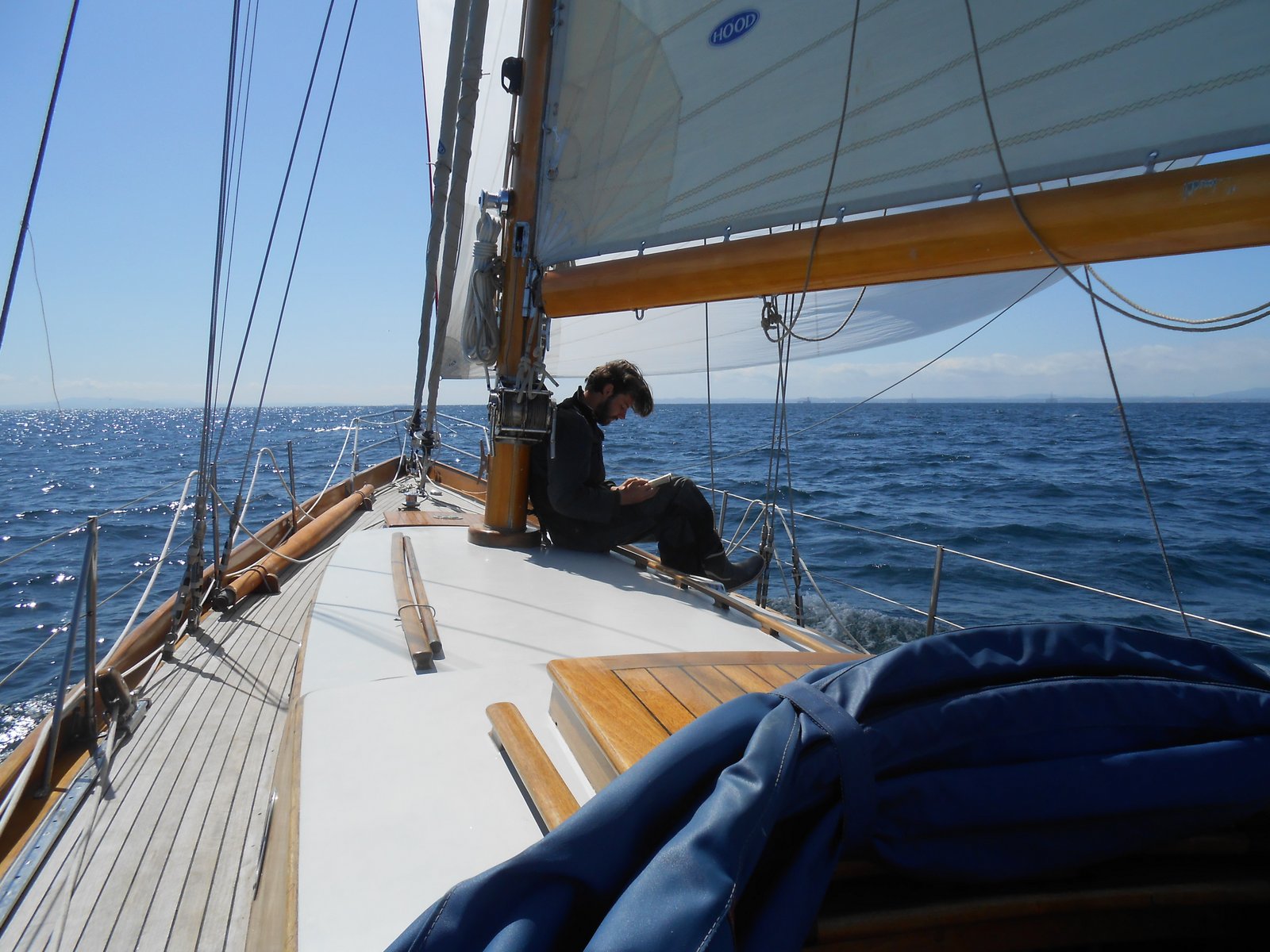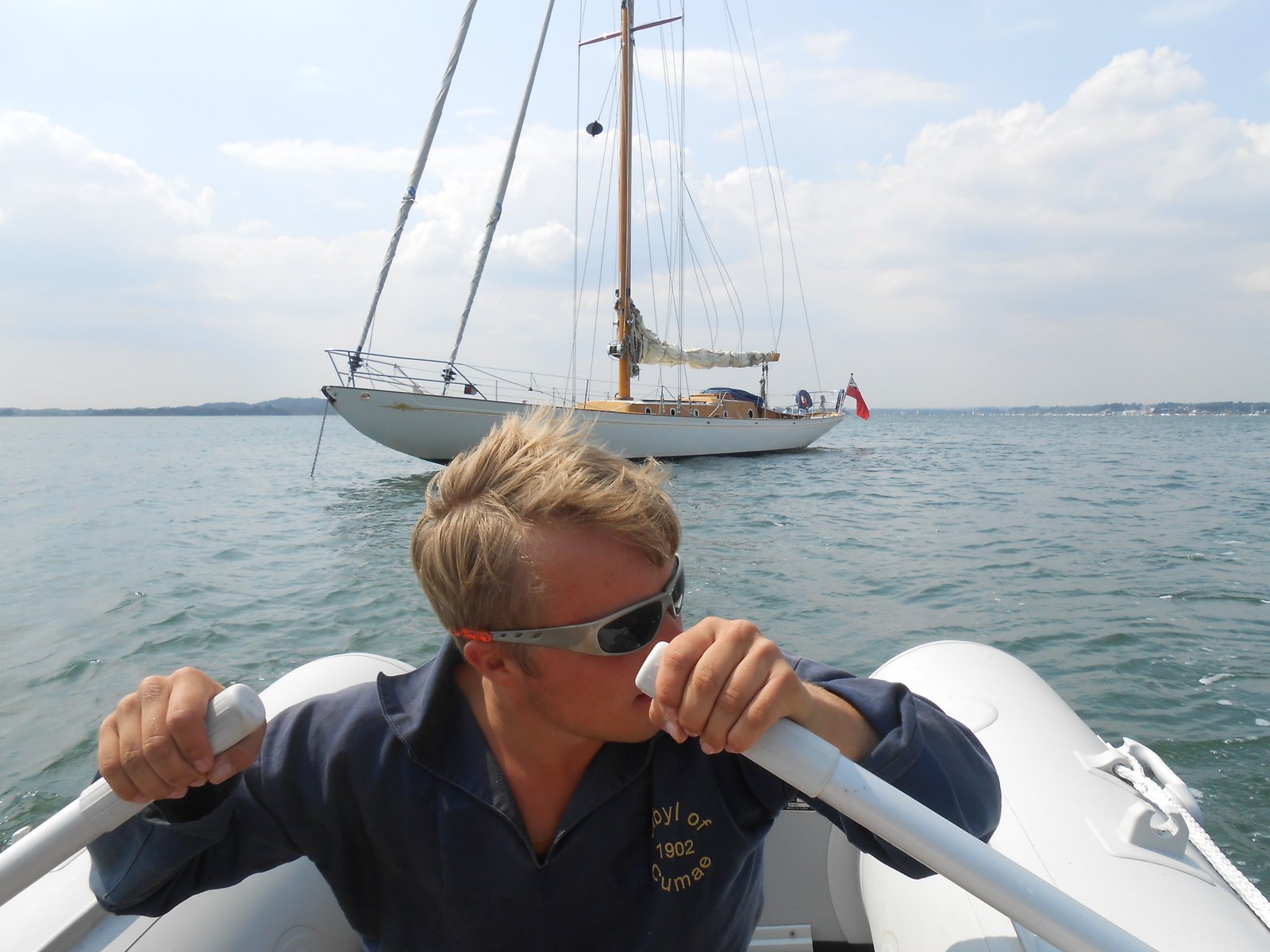Sailing clockwise around the UK in a 1902 yacht
Returning to where Sybil was built
Visiting Barra, St Kilda and Scapa Flow
We took the Old Girl for a spin…
By Cornelius van Rijckevorsel
We had planned this trip to attend the Fife Regatta, but sadly it was cancelled (though it is running in 2020)… so we set off regardless. Although Sibyl of Cumae is a Scottish boat, she is an unlikely candidate for an Atlantic cruise. She was built in 1902 by William Fife III as a day racer for the protected waters of the Clyde. We had prepared well, reconditioned the old Eberspächer and lots of warm clothes. We didn’t use the heating once. Via our friend Caroline I inherited Jon Castle’s, captain of the Rainbow Warrior, foul weather gear, very thick and warm, I did use those! We set off from our home port of Plymouth on the 15 of June and had 3 days of very unpleasant weather, We sailed to Falmouth on the first day and visited the Int. 8 Metre Pinuccia on her mooring at St. Mawes. We met up with our old friend and fellow classic boat sailor Nick from Penlina. Both Benji and I sailed with him in the Golf de Morbihan. The constant crew for the whole passage were Benji; Aric and me, with 2 places spare for changing crews. We also had my daughter Millie and her friend Cecily on board and they behaved very bravely under these conditions, both looked green. We sadly skipped the Scilly Islands as it would have meant more upwind sailing in big waves. As soon as we had the wind abeam, behaved more evenhandedly, once we turned the corner at Lands End. We left our 2 young female crew members in Fishguard, Wales and sailed onwards, in the afternoon, for a breezy night in the Irish sea. Soon we were clocking 10, 11 and 12 knots arriving in Dublin the next morning at 03.30 hrs. Excited we had made it this far, we opened a bottle of wine on the visiting pontoon in the middle of the night, in Dun laoghaire, having radioed in phonetically. It felt as if the journey had now really begun. We were 3 days early, as there was strong northerlies forecast, to pick up my son Ignas, flying in from Amsterdam.
Lots of little repairs to do and nothing helps better to get a quick feel for where you are than having to look for things for the boat, quickly discarding the main chandlery and getting bits and bobs together elsewhere, even a car scrapyard. Aric became our phaffer in chief. We did sail out on the 3th day to look at the local regatta and Aric was invited on one of the competitors yachts to take part in the race. As soon as Ignas arrived we were ready to get on with our trip, not even having been to Dublin. Left at 0800 in the morning and sailed up the Irish sea. Conditions were perfect for Sibyl. I kept in mind the shipwreck of the Oona in 1886 nearby. It also was the 20th year after Eric Tabarly was lost overboard in the Irish sea, sailing 100 year old Pen Duick to the Fife Regatta. Pen Duick too is a 36 Linear Rater, from 1898, 4 years senior to Sibyl. We had a magical moment, when all 4 of us had lunch on the fore deck, spinnaker up and automatically steered by our faithful Will-helm. Sun and a force 2-3, we realised how fortunate we were, just being at sea in such spectacular conditions. But of course it could not last and we had the kilo pot of peanut butter spill over the teak deck to remind us that perfection can only be attained temporarily. We sailed on to the top of Arran and anchored and stayed overnight in Lochranza. The main reason being that my son wanted to visit whisky distilleries. We duly did the tour and acquired a bottle for our friend Eddie Crawford who lives near Glasgow. He had ordered a gusher for the sink pump that leaked which we could not get in Dublin. He also lent us his pilot guide for the Outer Hebrides which I didn’t manage to get hold of before we left. All the rest, charts and pilots were borrowed off the other Fife yacht in Plymouth, Sonata, thanks Paddy and Robin! So the bottle was for Eddie. Arran is beautiful and you can see it for miles because of its high mountains.
We came across a lovely Scottish Island Class yacht moored nearby. The old boy showing off a nicely faded red Balmoral tam o’shanter that made me jealous and looking for one in vain in Edinburgh later. We set off from Arran the next morning in a light breeze, catching up a modern yacht, but we had to put the motor on after a while, when the wind ran out. There was a small house in a beautiful setting on the North coast of Arran, all by itself, ideal for my hermit aspirations. We motored into the Clyde, South of Great Cumbrea island, towards Fairlie, 116 years ago the birth place of our beloved boat and we planned a sail past the spot where the Fife yard used to be, nothing now remaining. There was a row of moored boats off the beach and Ignas and Benji went into the blow up dinghy to make photographs. I didn’t want other boats in the image, so we came closer into the shore and Aric even put the spinnaker up for just a minute, in very little wind. We could see the bottom and were in very shallow water. The pictures are beautiful, but we were nearly aground. We must have looked pretty stupid from land, but we just managed it all without making fools of ourselves. Sibyl was built on this shore, hence the triangular keel, mimicking the incline of the beach. It would have been ridiculous to have stranded her here, but we got away with it and nothing of that shows on the photograph.
On, northwards into the Clyde, where we had an appointment with Eddie and the gusher and a new crew member, Noud, flying in from the Netherlands the next day. We stayed over at Rhu Marina and someone was on the pontoon when we arrived. We thought he was the harbour master, but it turned out to be Eddie. We exchanged the whisky for the pilot guide and the gusher and proposed a drink. Eddie wanted to taste his new bottle, but couldn’t drink himself as he still had to drive home. A bit embarrassed we proceed to drink his bottle and ended up very drunk but having a great time, finishing in a fish and chips shop in Helensburgh. Showers; water intake and topping up on electricity, the usual things we go to marinas for. Leaving the next morning, I had planned well our exit, which is always tricky with an offset prop and no keel yet under the mast. Going astern she’ll always put her backside into the wind as soon as it catches the high mast. She is not a marina boat. Somehow the forward gear would not engage and we were going backwards into an other boat. Luckily the 3 guys on the aft deck managed to keep us from touching the boat behind us, but Benji lost his watch in the water and we snapped the flagpole. One piece was missing in the water and Benji and Aric went back into the marina in the dinghy to pick up the missing bit of wood, so we could glue everything back together. We were unaware that Faslane was at the end of the Gare Loch and Eddie also pointed out Queen Victoria’s holiday home across the water, next to where the old McGruer boatyard used to be. I ignored that these yards were so close together, with Mylne’s yard on the Isle of Bute, just 10 miles away. It truly was the epicentre of boat building one hundred years ago. Sibyl lived here most of her life.
Sobered up the next day, we left for Greenock, across the Clyde to pick up Noud. We landed in an disused dock, Victoria harbour, just for an hour or so and got the lead line out to see if we were in trouble or not, but over 4 metres was well deep enough for a while. As Sibyl was first registered in Greenock we almost felt entitled to be there. Whilst waiting for Noud to arrive, the boys went for a big shop nearby and we set off in the afternoon for the Crinan Canal in a big W shape, via the Firth of Clyde, the Kyles of Bute into loch Fyne, where we anchored for the night in Glac Mhor. Up early to catch the first lock opening of the Crinan Canal.
At the sea lock, there was another boat waiting to get through the canal. After having paid for the passage we got our first step up. In the second lock this very beamy plastic yacht came racing in and banged in reverse once he was in, pushing on our fenders. We usually go dead slow mooring anywhere. After 3 or 4 times of the same story, we let them go in front and stopped for some lunch. Much better this way. You can have a guided passage, but we just opened and closed our own locks. A lock master cycled all the way to assist the other people. There was enough water in the canal and we arrived in Crinan in the afternoon after a hot day working the locks. We stayed overnight in the inner basin. Crinan is very pretty, all works perfectly and the views are stunning across the loch to Duntrune Castle, almost like a manicured Japanese landscape. We had a couple of drinks and met Mike Johnston, who remembered Sibyl from the 1960’s. He did email me a write up of Sibyl’s journey to Denmark in the summer of 1958. A very different affair, with days spent wallowing in the North Sea in a storm and a 15 hours hove-to in too much wind; an almost collision and a 4 days and nights hove-to in a storm on the way back. He writes that Sibyl was on her beam’s end. We planned our entire passage with the wind predictions, which these days are pretty accurate. The weather kept being favourable for taking big steps.
Sailing out of Crinan, with a sideways glance into the Corryvreckan, we sailed on to Mull, where Ignas decided he would come after all to St Kilda with us, instead of flying home to Amsterdam. So we turned West and got to the Sound of Iona. We were advised to anchor in Tinker’s Hole, a tight anchorage, but all boats turn at the same time. There were some 6 other boats already anchored. We put ourselves in the middle of the wider part and the tide would either stream North or South. We went to bed after a nice meal. The next morning we had turned, but we were laying on the wind instead of the tide, an Easterly and less then 2 metres from the rocks, so we quickly got ready for leaving. With quite some wind we sailed out of the Sound of Iona towards Tiree and Coll, going past the funnily shaped islands of Treshnish, Lunga and Staffa. Mendelssohn was duly mentioned, and Fingal’s cave, but we were on a mission and didn’t stop off. We passed between the islands with everything up and rapidly overtook a polyester cruising boat. On board was a professional photographer, Genevieve Leaper, who made some stunning photographs of our passage through the Sound of Gunna (see right).
Beautiful day and we got to Barra in the afternoon. Castle Bay is very pretty and well sheltered. That night there was a ceilidh organised in the local pub and we could hear the music over the water. The boys went investigating and it turned out to be the best evening of the year. My crew are hardened party goers, so this must have been very special. Apparently the whole pub went mad and they happily joined in. We did stay another night for the guys to emerge and we had a sedate day visiting the castle in the water. Rain initially and a lot of wind that afternoon, we had to clear out of our anchorage because the ferry could not land and we were forced to use the pontoon for the night.
St Kilda was beckoning, a big step, 80 miles in the open Atlantic. We left with a first reef in the main from Castletown, another boat following us out in the early hours of the morning, she was a modern classic, an Andre Hoek design and looked like a very powerful cruiser, she dropped behind and we saw her later back on St Kilda. At the end we had to put the motor on as the wind dropped. We got to Hirta, a well sheltered bay in West and South Westerly Winds. Apparently we were lucky, later people asked me if we were able to land. Yes, it was very calm and comfortable, we even swam. Thousands of puffins darkened the sky when I took the dingy out for a closer look at the interesting rocks on the South side of the ancient crater formation, with natural arches opening to the Ocean.
I had been wanting to go to St Kilda ever since I read Ian Rutherford’s book At The Tiller about his journey in 1937 in the Int. 6 metre Sheila, then owned by my friend Lorna Rice, with a nice photograph of him sailing back to the Hebrides in a force 8, on a run, 2 open cockpits.
So we got there, it was a long way, but this was my destination. St Kilda is an island group that was inhabited from 3000 bc until 1930. Bits look prehistoric. It is basically one arched street following the shoreline, a bit inland. There are ruins of houses and older stone huts; enclosures and dotted all over the valley stone constructions called cleits, small warehouses, all the way up to the top of the hills. The people used to survive on sea birds and they would sell their down to pay rent to the owner of the island, the Macleod family.
It is a world heritage site, but sadly the MOD plonked barracks right in the middle of it. There is a missile guiding system at the top of the hill and the splendour of the sight is tarnished by their activity. Land rovers, helicopters and heavy equipment going about noisily, building new barracks. At midnight it was still light enough to read a book outside and by 4 it was light again. The next morning we went ashore for a good hike up the mountain and I am glad we took a crew photograph. At 14.30 hrs the shop opened for an hour and I wanted to be there to find an interesting souvenir. We were completely independent for food electricity and water, no internet and no phone signal. So I couldn’t contact my brother Peep for his birthday.
On the 4th of July we sailed out of Hirta, North of Boreray in North Easterly direction towards the Orkney Islands in light Westerly winds, past the Flannan Islands and North of Lewis, over the top of Scotland. It was a long stretch, North of Lewis we had a few bars of telephone reception and were able to phone home to say all was well, after several days of no contact. There was a force 8 wind warning further North in Faeroes. We arrived early morning at the entrance of Scapa Flow, between Hoy and the main island of Orkney. The Pilot guide warned not to get in against the tide. The wind got up and we had to wait for the tide for 2 hours to get in, so we went up and down the coast before entering. The tides are strong there as the whole of the Atlantic and the North Sea sluices through the islands like a sieve. By now it was a force 6 and trying to winch in the furling line for the jib, wildly flapping, it tore the UV strip of the leach of the sail. So, next time, better to go well down wind and take it in then. We looked a bit shabby because of it, getting in to Stromness. I enquired if there was a sailmaker on the Orkneys, but the lady had stopped working. Someone at the Maritime school might help out. So I met Marc during a class he was giving. After 5 he got on board and was pleased to see a vintage boat like Sibyl. He showed me how to do the herringbone stitch. Some of the UV fabric had really disintegrated from the flapping and he told me he would come back the next morning with his sewing machine. Once I got the hang of the stitch I continued doing the whole lot and as the boys went out for drinks, I sat on the fore deck in the dark with my head torch until all the seams were finished. The next morning Mark, the director of the Nautical School, was surprised the lot was hand stitched, he had never seen such neat stitching. He put some new bands of fabric over the worst bits and only asked for a donation for the RNLI, which we duly paid, very happy to have the sail back working. With the boat back in order we had a look around town. There is a surprisingly nice small art museum in Stromness, free to visit. We did of course go to see Skara Brae, the archeological site, it was very beautiful and well presented, they even had a proper replica build of one of the houses to walk through. In the afternoon I set off by bus for the isle of Lamb Holm, to see the Italian Chapel, built by Prisoners of war, in a Nissen hut. The emotion is authentic but the execution is of a hideous neo-gothic style. If it wasn’t religious it would have been camp. The oppressive shape of the half pipe building clashes with the tromp l’oeil. The POWs were working on damming off the Eastern side of Scapa Flow, as there was a concentration of the British Navel fleet there during the Second World War. A German U boat had managed to sneak up to an ammunition ship and blown it up, with the loss of 800 lives. At the time the British thought it impossible to sneak in as there were a lot of wrecks blocking the passages already. It was Churchill’s idea to build these dams. There is now a road connecting the main island to the ferry at Burwick.
We were keenly aware that we were now half way in our journey, the furthest point from our start and unsure what the North Sea had in stock. We did take big leaps from there on, in one go to Edinburgh. We sailed into the Firth of Forth where we spotted a whale. Under the two older bridges and before the third one is the marina for Edinburgh, at Queensferry, on some sort of decrepit industrial estate, an hour by bus from the city. It was the least favourite marina we had come across. The guys who helped us get in were very friendly though. We stopped off for 2 nights and plunged into the mass tourism of Edinburgh. We had a walk around the city and ended up sitting under a tree in the park under the castle. Both Ignas and Noud left us at Edinburgh and Evie, Aric’s girlfriend and Isaac came on board. Evie had already been on Sibyl during a race in Plymouth, but I had not yet met Isaac. He is a friend of Aric and Evie, from Totnes and had just finished his art degree in Edinburgh, so lots of conversations. Off South now in one big jump, a mix of motoring and spinnakering. We wanted to stop at Lowestoft for Benji to have an interview at the boat builders school, but we got there late Friday afternoon with the school closed for the weekend. I wasn’t prepared to wait until Monday, so we sailed on to Ipswich. Jonathan Dyke from my old yacht club runs the Marina there and I wanted to say hello. He had left for Cowes to attend the British Classic Yacht Club regatta. We landed at a completely wrong place in the marina and we were in the way of a handicapped sailing scheme. We did manage to get out and relocate. It was hot and windless. We had a look at some interesting boats on the hard and took in food; water and diesel. Isaac left us in Ipswich.
Now there was some interesting sailing ahead, across the Thames estuary with all the sandbanks and separation zones for commercial traffic we can’t go into, except crossing at a right angle. These waters are heavily monitored and huge fines for any infraction. We carry AIS so they would know who we are, our speed and heading. We got through without a problem and the early morning watch passing in front of Dover dodging ferries. We timed our tide right and didn’t stare at Dungeness for hours, it actually passed by whilst I was off watch and asleep, for which I was grateful. To me one of the bleakest places to sail on the English coast. We arrived in Brighton and got into the marina late afternoon. It is built out from the beach by artificial concrete towers into the sea. On the radio the harbour master told us we might just touch the ground, in fact, it being springs, Sibyl’s stern was a metre out of the water at low tide. It looked awful. When she was afloat again, later that night we relocated her next to a boat called Rolling Stone, John Caulcutt’s old ferro cement boat, which he sailed around the world in.
The next day a compulsory outing to the Royal Pavilions for the whole crew. I love it as it is so brilliantly over the top, always tasteful. Indian architecture outside and Chinese on the inside. Big stroll through town. I had contacted BCYC to request a visit during their regatta and was welcomed. We got there early, it is great to work with the tides all the time, although it meant getting up in the middle of the night sometimes. We did see all the boats competing and we sailed westwards with them through the Solent and back, getting in after everybody. We got to moor up next to Kismet, also a Fife, recently restored and looking completely pristine. The whole Panerai atmosphere came back to me, with drinks and wristbands and security. We saw lots of old friends from years ago and it was great to be there just for the day. Evie left us at Cowes and we were 3 again, Benji, Aric and myself. We did manage to take in water although there was a hosepipe ban and the marina had taken their hosepipes off the taps. On my birthday we left Cowes after lunch, with the classic fleet, they for their long inshore race and we to an anchorage behind the gravel spit of Hirst Castle at the western entrance to the Solent, across from the Needles. We touched bottom a few times, in soft mud and took up one of the free moorings in the deepest bit of the marsh. It was a beautiful evening with lots of sea births. We were now in well known waters and deliberately slowed down as the end of the journey was close. So next was a small hop to Poole, anchoring behind Brownsea Island, the furthest we could go around before running aground. We had a walk over the island and an ice-cream at the castle. The Scouting movement started on Brownsea Island in the early 1900’s and there were a lot of Dutch refugees during the war on Brownsea.
Next was Poole to Lulworth Cove, through the St Albans Ledge. It was neaps by now and we crossed the ledge downtide in quiet weather. I have been here in different circumstances and would normally sail out 15 miles to avoid it. It was fine and we entered Lulworth Cove and anchored in the middle. Millie was coming back on board for the last few days of the journey, lovely to have her back. It was a hot day with a lot of tourists, but it quietened down in the evening.
Next we sailed well out of Portland Bill races and across Lime Bay. It was much less daunting in Sibyl then in my previous boat, a third smaller and no accommodation. We landed in Torquay, but weren’t lucky with facilities there, so we sailed on to Dartmouth, arriving in the evening. Aric’s father came by with Evie and she stayed on until Salcombe. We ended up alongside a Dutchman who came on board for a drink and got everybody suitably drunk on Schippersbitter, a Dutch herbal gin. Another nice sailing day to Salcombe where we anchored across from the town, in front of a French catamaran who was wildly swinging on the wind and tide, whilst we were sitting motionless in the tide. Even the hammock came out for the first time on this trip.
Now we could no longer delay our return to Plymouth, unless we would put into the Yealm. We got back into Plymouth Sound on the 24th of July by 10 o’clock. Benji sounded the fog horn at the entrance of the Breakwater and Aric played trumpet. Very light winds, but we couldn’t resist pulling up the asymmetric spinnaker for the last time at Drakes Island, knowing Benji’s parents were there to welcome us at Devils Point. Aric played ‘Fanfare For The Common Man’, Aaron Copland, on his trumpet and we had a policeman spontaneously stand to attention on Devils point to welcome us in. 11 o’clock back on the mooring, a week earlier than planned, and no significant damage to the boat and no one got hurt. This was a very big journey for a 116 year old boat. She was happy to have been back to her home waters and we were exhilarated sailing for this amount of time, seeing some very beautiful places and wildlife. Thank you Sibyl for keeping us all safe and congratulations everybody who helped this epic voyage come through.
Main image shows Sybil sailing by Fairlie, where she was built on the Clyde
Length Overall: 51.57 feet (15.73 m)


